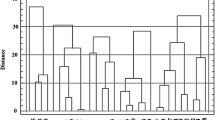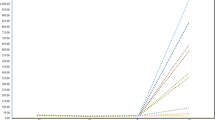Abstract
A total of 179 garlic (Allium sativum L.) accessions were collected from various parts of Nepal in 2000. Each accession was planted in each of a plot of 2.25 m2 at the Institute of Agriculture and Animal Science (IAAS) Horticulture farm (225 m asl) and at the Agriculture Research Station, Dailekh (1400 m asl) of Nepal Agriculture Research Council (NARC) in the first week of November 2000. All accessions were characterized for leaf erectness, leaf color, leaf wax, leaf cross section, bulb regularity, bulb skin color, bulb outer scales number, days to emergence, bulbing period, number of green leaves at 135 days after planting, days to maturity, plant height, bulb weight, bulb diameter, number of cloves per bulb, clove diameter and bulb yield. Data were analyzed by using principal component and cluster analysis procedures to reveal three major clusters. Four principal components were identified explaining more than 86% of total variation. Major characters included in the principal components were bulb weight, diameter, yield, number of cloves per bulb, maturity, plant height, number of green leaves at 135 days after planting, and bulbing period. The level of variation found in the collection showed the great potentiality of improving agronomic characters in garlic.
Similar content being viewed by others
References
N.U. Ahmed M.M. Hoque (1986) ArticleTitleStudies on the performance of some indigenous and exotic garlic germplasms in Bangladesh Bangladesh Hort. 14 19–24
M. Al-Zahim H.J. Newbury B.V. Ford-Lloyd (1997) ArticleTitleClassification of genetic variation in garlic Allium sativum L. revealed by RAPD Hortscience 32 1102–1104
S.P. Bhattarai (1996) Evaluation of local and exotic garlic germplasms for maize-garlic and rice-garlic cropping systems in the Western hills of Nepal during 1993/94 season Lumle Agriculture Research Center Kaski, Nepal
K.F. Bradley M.A. Rieger G.G. Collins (1996) ArticleTitleClassification of Australian garlic cultivars by DNA fingerprinting Aust J. Exp. Agri. 36 613–618 Occurrence Handle1:CAS:528:DyaK28XlvVWgtLY%3D
Burba J.L. and Riera P.G. 1997. Characterization, adaptation and selection of garlic germplasm (Allium sativum L.) through the management of dormancy in Mendoza, Argentina. In: Burba J.L. and Galmarini C.R. (eds), Proceedings on First International Symposium on Edible Alliaceae. Acta Horticulturae 433, pp.151–164.
R.MFritschN. Friesen 2002 Evolution, domestication and taxonomy H.D. Rabinowitch L. Currah Allium Crop Science: Recent Advances CABI Publishing5,30
R.P. Gupta D.K. Singh (1998) ArticleTitleStudies of the performance of different advance lines in garlic News Letter: National Horticulture Research and Development Foundation 18 13–18
M. Ipek A. Ipek P. Simon (2003) ArticleTitleGene Comparison of AFLPs, RAPD markers, and isozymes for diversity assessment of garlic and detection of putative duplicates in germplasm collection J. Amer. Soc. Hort. Sci. 128 246–252 Occurrence Handle1:CAS:528:DC%2BD3sXhs1yku78%3D
InstitutionalAuthorNameIPGRI (2001) Descriptors for Allium (Allium spp.) International Plant Genetic Resources Institute Rome,Italy
Lallemand J., Messian C.M., Briand F. and Etoh E. 1997. Delimitation of varietal groups in garlic (Allium sativum L.) by morphological, physiological and biochemical characters. In: Burba J.L. and Galmarini C.R. (eds), Proceedings on First International Symposium on Edible Alliaceae. Acta Horticulturae 433, pp.123–129.
J.A. Menezes-Sobrinho J.M. Charchar Particlede F.A.S. Aragao J.A. Menezes-Sobrinho Particlede (1999) ArticleTitleMorphological characterization of garlic germplasm by multivariate analyses of principal components and canonic variables Horticultura Brasileira 17 96–101
M.R. Pooler P.W. Simon (1993) ArticleTitleCharacterization and classification of isozyme and morphological variation in a diverse collection of garlic clones Euphytica 68 121–130 Occurrence Handle10.1007/BF00024161 Occurrence Handle1:CAS:528:DyaK2cXhsF2jsbY%3D
InstitutionalAuthorNameSAS Institute Inc. (1999) SAS/STAT. User’s GuideVersion 8 SAS Institute Inc. Cary, NC
P.W. Simon (2001) The origins and distribution of garlic: How many garlics are there? USDAARS, Vegetable Crop Research UnitDepartment of HorticultureUniversity of Wisconsin Madison, WI 53706
M.C. Singh R.S. Tiwari (1995) ArticleTitleYield and quality attributes of garlic (Allium sativum L.) accessions Haryana J. Hort. Sci. 24 46–49
Author information
Authors and Affiliations
Corresponding author
Rights and permissions
About this article
Cite this article
Panthee, D.R., KC, R.B., Regmi, H.N. et al. Diversity Analysis of Garlic (Allium sativum L.) Germplasms Available in Nepal Based on Morphological Characters. Genet Resour Crop Evol 53, 205–212 (2006). https://doi.org/10.1007/s10722-004-6690-z
Received:
Accepted:
Issue Date:
DOI: https://doi.org/10.1007/s10722-004-6690-z




